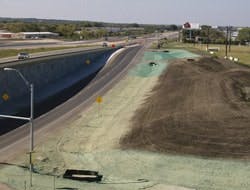Making the Grade
To remedy the increasing traffic congestion in Central Texas, the Texas Department of Transportation and the Texas Turnpike Authority developed the Central Texas Turnpike Project (CTTP), ranked as one of the nation’s largest construction projects.
The CTTP’s largest component is a 90-mile stretch of Texas State Highway 130 (SH 130). When completed, SH 130 will extend north of Georgetown to I-10 near Seguin and represent a $1.3 billion investment. Like any other large-scale project, there were a few glitches along the way.
In late summer of 2006, slope revegetation on SH 130’s first two segments, which totaled about 20 miles, was running behind schedule. One reason for the delay was the soil conditions found on many of the project’s cut-and-fill slopes, which ranged from rocks and shale to sandy clay. Reclamation contractors had difficulty achieving the optimum grade conditions needed to use rolled blanket-type materials for growth establishment. In addition, SH 130’s convergence of slopes and multilane pavement on banked curves created areas where heavy runoff could concentrate.
Solutions
The primary contractor for this project is Lone Star Infrastructure, a consortium of engineering and construction firms. Geo-Solutions Inc., located in Austin, Texas, proposed to Lone Star that it use Profile Products’ Flexterra Flexible Growth Medium (FGM), since Flexterra has proven to establish growth under these challenges.
Flexterra's patented technology combines thermally refined wood fibers; crimped, interlocking, man-made fibers; and performance-enhancing additives to provide erosion protection and seed germination on slopes. With greater than 99% effectiveness in controlling soil loss, Flexterra requires no cure time, providing immediate protection against erosion upon application. Flexterra also absorbs and holds 15 times its weight in water, delivering more moisture to the seedbed for faster vegetation establishment.
Lone Star accepted the proposal and two tests were conducted in August 2006. Lone Star project specialist Mike Bagby supervised the revegetation of the 2H:1V slopes.
Given the demonstration’s success, Lone Star put Flexterra on 80 acres of SH 130’s first two segments. Geo-Solutions also recommended the GreenArmor System for speedy revegetation in ditch areas. The GreenArmor System combines Enkamat Turf Reinforcement Mat (TRM) with Flexterra to protect against elevated levels of hydraulic lift and shear forces on slopes and in channels, while encouraging fast turf establishment and long-term root reinforcement. When fully vegetated, the GreenArmor System can double the effectiveness of natural vegetation and replace hard armor systems at a fraction of the cost.
Results
Switching to Flexterra and GreenArmor was a positive factor in vegetating the slopes and ditches along the two SH 130 segments and helped get them where they needed to be before the year-end deadline.
“Using Flexterra and GreenArmor for this project not only gave us turf establishment, they gave us good experience for using them on other project segments,” said Bagby.
